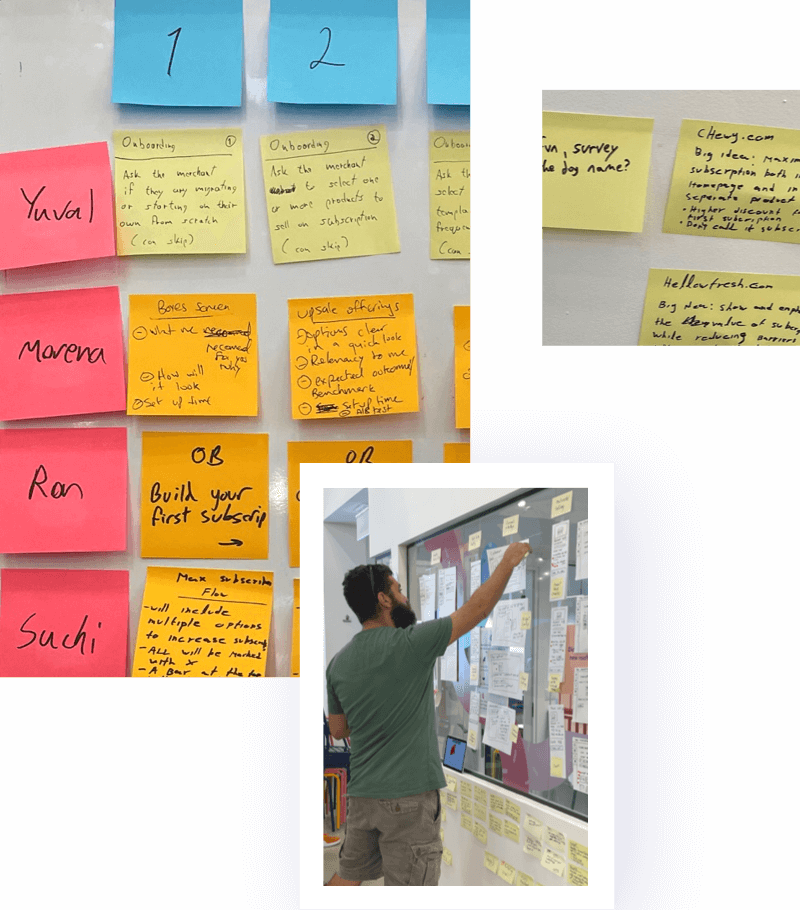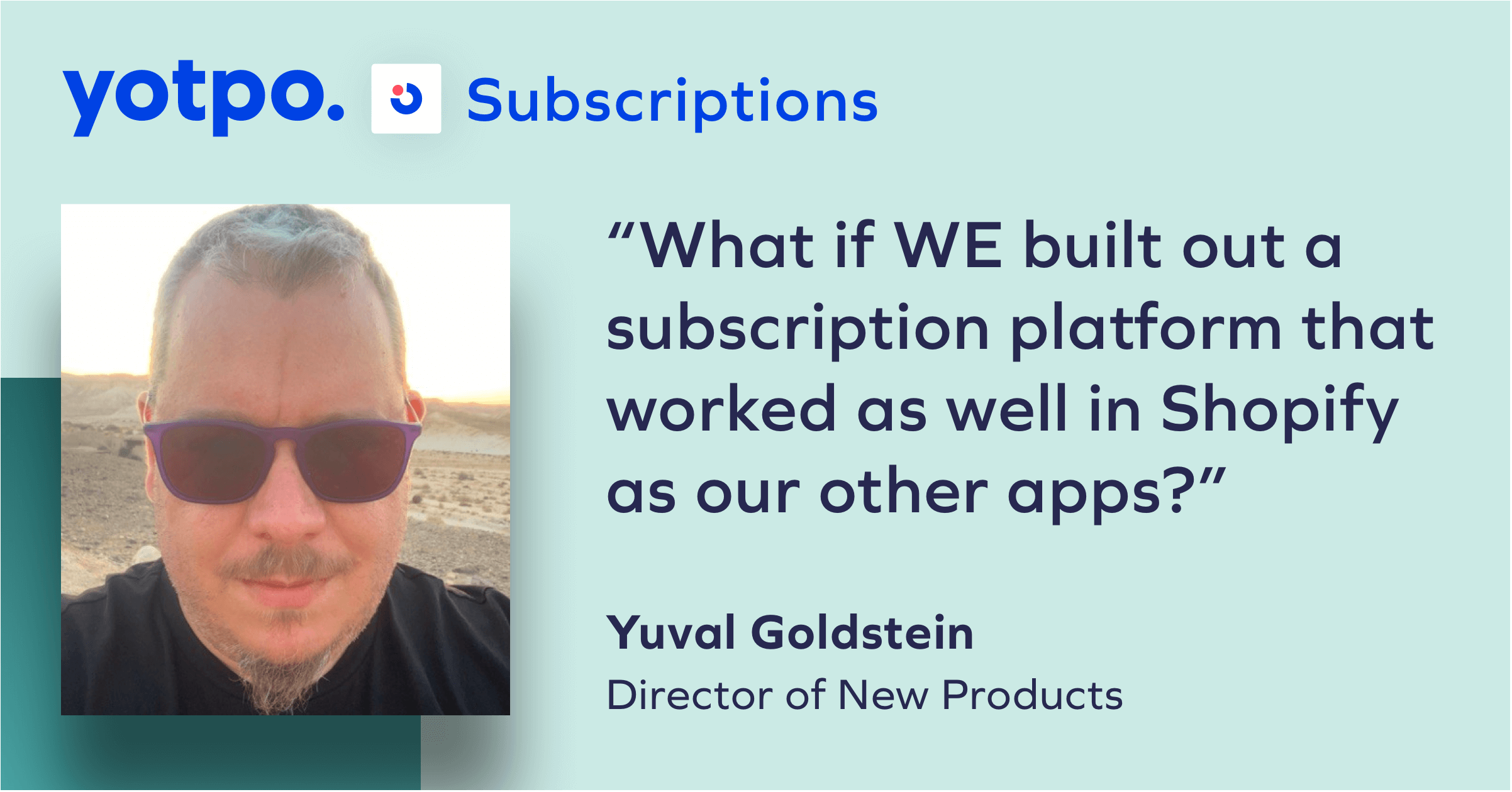I’m never more proud than when a product launches successfully to a hungry market. I feel humbled to have felt that multiple times over my tenure with Yotpo. My name is Yuval Goldstein — I’m the Director of New Products here at Yotpo.
The launch of Subscriptions marks my fifth year of product development with the company. I originally joined to lead Reviews and Visual UGC after coming fresh from Microsoft, Wix, and a handful of other small startups.
Subscriptions has been my pride and joy for the last year, and I’m excited to share the story, my thoughts, and insights, the process, and my hopes and expectations for the product moving forward.
Where we started
Three years ago we had a series of conversations with several Yotpo brands — some in leading market positions, and some not — to understand their focus. We centered these conversations around the question, “What is the next step for your business?”

Subscriptions design sprint
What followed was several days of brands voicing the same thing on repeat — they needed to shift to a retention-first approach and were looking for tools that would make that easy. Their current options were clunky, didn’t integrate well into their current marketing tech stack, and made everything feel harder than it should be.
Ultimately there was this resounding need for an easy-to-use subscriptions app that could reduce the dependency on acquisition and increase retention. We understood this was the macro need for eCommerce as an industry, but we really started to hone in on how we could add cross-functional value to our current product portfolio, using these brand’s pain points as our guiding light.
We managed to group the biggest concerns into three overall thoughts:
- Current market apps are not easy to use for merchants or their customers
- A standalone subscriptions app wasn’t going to be enough, merchants still need to invest a lot of time to drive new subscriptions
- Existing apps do not integrate well with Shopify
So we asked the big question, “Why Yotpo?” What were we going to do that made us the obvious choice when picking a subscription app?

The first two thoughts reinforced that if we did build this product we could definitely integrate it with our current offerings:
- Leverage Yotpo SMS & Email automation to run smart campaigns
- Use Loyalty benefits to drive shoppers into subscriptions and increase retention
- Reinforce Subscriptions inside of Reviews and UGC to show people just how easy it is to sign up and stay loyal
The third thought is an evergreen goal for Yotpo — our aim is always friendly, intuitive, easy-to-use apps that do the work for you. For so long, Shopify didn’t require apps to be certified, so a lot of developers were producing incompatible apps — just so they could be in the store. They weren’t functional, and they by no means were friendly.
We’ve had a strategic partnership with Shopify for several years now. Our other platforms and products integrate seamlessly — so even if new subscriptions apps were starting to improve quality, our goal was to be the best, built natively into Shopify.
I think it’s important to note here, that even though none of these brands actually verbalized this, a lot of this headache also came from a lack of support. Most people were experiencing long and confusing processes while setting up other apps. They had to rely on the checkout experiences provided by the other subscription apps, these are not native to Shopify. Merchants also had to code in discounts and products to Shopify as well as the competitor app — it just got really, really messy.
Building a product from the ground up is a long and bumpy process, but we truly believed we had an opportunity to address a pain point in the market that would have a huge impact on brands and their businesses. So we tested the waters — we built this very primitive skeleton of Subscriptions, something the merchant could easily set up themselves.
In those early days we, the product and R&D team, manned everything ourselves. There were so many pieces that needed to come together and we kept a very lean team while we built this product out, that meant no CSMs and only one person designated to support. We did it on purpose because we wanted to see if the app was intuitive enough for a brand to download and launch on their own.

We offered that skeleton subscription product to five customers, “early birds” we called them, and then worked with them on a nearly day-to-day basis, building out the structure on a very quick turnaround.
These early birds would say, “It would be nice to have this,” or “We really need this kind of functionality.” They would also report bugs and errors, and our development team would turn them back around within 24 hours. It really was a 24/7 operation with these brands.
This process also gave us the chance to really dig in and figure out how to better ourselves, how to take all of our learnings and create something that was going to, in turn, help our customers better their businesses.
Luckily, we could rely on our good relationship with Shopify to guide us through this product build. We have been able to integrate our app in a way that creates smooth experiences for merchants and shoppers. Shopify was very adamant that we create a very friendly experience for shoppers and we’ve worked together with their app certification team to ensure we’re building a quality solution.
Testing, testing
Once we were Shopify certified and addressed the biggest market bugs, we wanted to test it out on other customers.
Our aim was pretty simple to start. Between September ‘21 and January ‘22, we wanted to find 10 brands that could set up our app natively in Shopify in under 30 minutes. We got a variety of brands from every corner of eCommerce — beauty, sports, cosmetics, food and beverage, clothing — and we put them to the test.
Across all fields, we thought the half-hour marker would be a pretty good indicator of success. The average setup time was seven minutes. This was a huge milestone for us, we had created something completely intuitive. The team, myself included, was very proud of what we were able to accomplish.
We’d monitor the data and session recordings so closely, every day. We wanted to know exactly where people got hung up, or confused, and why — and then again, we’d bug fix in 24 hours, update, and push it out.
And so this process continued for several months. Observing, fixing, and redeploying.
Time for launch
This phase between the early birds and some beta testers was going so well that we soft-launched on May 9th. Finally, after another month of polishing, we officially announced the product on June 8th. The numbers are growing by the minute, but to date, we just surpassed 600 active brands.
The future of this product looks great, as well. The SMB space is looking incredibly successful with subscription rates in the thousands, but we’re all working furiously to integrate the product with SMS and Loyalty so brands can further their reach and continue to scale.
In fact, before we even went live with Subscriptions in June, we suggested one of our brands run a Yotpo SMS & Email campaign — probably one of our best case studies before opening. As I remember, they had some 60 regularly active customers. After running a Yotpo SMS & Email campaign, that number jumped to 400+ active subscriptions.
Subscriptions has a lot of potential yet to be released, I think it’s going to bring a lot of powerful change not just to Yotpo, but the industry as a whole.
Subscriptions is really proving that it’s the way eCommerce wants to trend, and not only are we beyond delighted that people answered our questions and tried out our product through its lifespan of development, but we’re humbled and excited to see that it’s working, and bringing rapid, consistent, and powerful growth to brands that invest in it.
I think I owe a couple thank you’s to the teams and individuals that worked relentlessly to make this possible — developers, product marketing managers, writers, analysts, marketers, Shopify partners — everybody put in, and still continues to dedicate so much effort and bandwidth. This app migrates so fluidly regardless of where you and your brand are coming from, to get you exactly where you want to go.
It’s been so important to us that we stay on top, that we’ve got a dedicated brand migration team to make this so painless. It’s a game changer for Yotpo, and it’s a game changer for our customers as well. Best of luck, and I personally can’t wait to see what you accomplish with it!














 Join a free demo, personalized to fit your needs
Join a free demo, personalized to fit your needs